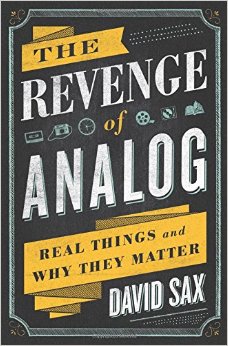 Prior to Christmas I was talking with a friend about a new book he was reading, The Revenge of Analog: Real Things and Why They Matter. The title is intriguing enough; however, as we talked, the concepts and arguments of the book echoed my experience. I was intrigued. I picked up the book and absolutely devoured it. My hunch is many people who read this blog will likewise find David Sax’s book to be a compelling read.
Prior to Christmas I was talking with a friend about a new book he was reading, The Revenge of Analog: Real Things and Why They Matter. The title is intriguing enough; however, as we talked, the concepts and arguments of the book echoed my experience. I was intrigued. I picked up the book and absolutely devoured it. My hunch is many people who read this blog will likewise find David Sax’s book to be a compelling read.
First, what is analog? Sax defines it: “Analog, in the broadest sense of the term (and the one I’ve grounded this book in), is the opposite of digital. Digital is the language of computers, the binary code of 1’s and 0’s, which in endless combinations allow computer hardware and software to communicate and calculate. If something is connected to the Internet, runs with the help of software, or is accessed by a computer, it is digital. Analog is the yin to digital’s yang, the day to its night.”
Second, how is it getting revenge? The author observed that certain technologies and processes that were rendered obsolete were suddenly beginning to show a resurgence–even as the world around them continued to speed ahead in a technological revolution.
“It was as though analog was becoming newly relevant, right as its very obsolescence was supposedly assured. The Revenge of Analog represented a resurgent and reimagined value for nondigital goods, services, and ideas, precisely when the transition from analog to digital was supposed to be total. But as digital technology assumed an increasingly large role in our lives, it almost seemed as if an alternative, postdigital economy was emerging as well. Although I first saw this trend blossoming in trendy urban neighborhoods, it quickly spread out into mainstream consumer culture. Initially it appeared as a trickle, but soon the Revenge of Analog was a torrent rushing all around me.”
Sax set out to observe what and why this is happening. Writing with the curiosity and precision of an investigative journalist he journeys (literally) around the world to get a better view and draw these conclusions. The book is broken up into two parts.
Part I: The Revenge of Analog Things examines the new markets for vinyl records, paper products, film photography, and board games, to show how the businesses that make and sell legacy analog goods succeed today by tapping into the fundamental consumer desires driving the growth of these products.
Part II: The Revenge of Analog Ideas draws lessons from publishing, retailing, manufacturing, education, and even Silicon Valley, to demonstrate the innovative and disruptive potential of analog ideas in today’s digitally focused economy, and the advantages they bring to those who embrace them.
As I mentioned, I found the book personally compelling. I have been writing with a pencil and filling up Moleskine journals for more than a decade. I love to touch the paper, fill it with led or ink, and then review it. I do much of my sermon work and planning in my notebooks. Over the last few years I’ve grown repulsed over how close my technology was to me; and how apparently dominant it was in my life. My phone in particular has gone through a number of demotions. Several months ago I removed email then social media and soon after a number of news apps. So much of my fight is not just removing stuff but adding other things that I find more enjoyable and beneficial. At the same time I’ve noticed here in Omaha and other cites throughout the country, a resurgence of the old analog world. Most cities have record stores, coffee roasters, craft breweries, old-fashioned barber shops, paper boutiques, and board game cafés. In a digitally focused world, cities—especially newly developed areas geared toward younger people—were beginning to show more and more analog tendencies.
I’ve asked the question that Sax asked: Why? He answers, “One reason is pleasure. Analog gives us the joy of creating and possessing real, tangible things in realms where physical objects and experiences are fading.” I don’t have any indication that Sax is of the Christian faith; however, several times (like this) he makes statements that we might say. In a sense he is saying, “We are embodied creatures. We’re incarnation beings; created by our Creator to enjoy the real, physical world.” The fact is, a lot of our technology disembodies us. As a result we lose some of the cherished benefits of being human.
In perhaps the most intriguing section of the book Sax visits with some of the leading tech companies. His observations at the offices and in the lives of the leading tech giants will certainly be illuminating if not completely shocking.
Is the revenge of analog anti-technology? No, not at all. It is however, calling for a thoughtful evaluation and balance.
No one, including myself, advocated a return to the predigital lives we once knew. No one was flinging their phones into lakes, or exclusively living off the grid. An entirely analog existence was unattainable and unattractive, but so was an exclusively digital one. What was ideal, and what lay behind the Revenge of Analog, was striking a balance between the two.
As you can tell I love the book. (I should provide a disclaimer that there is some language in it.)
You can pick up a copy of The Revenge of Analog: Real Things and Why They Matter by David Sax at Amazon.


















